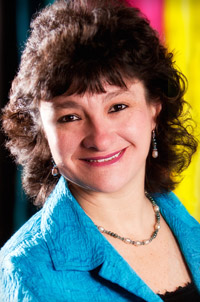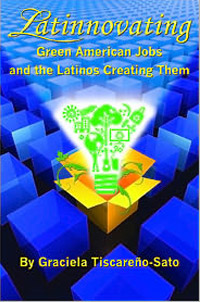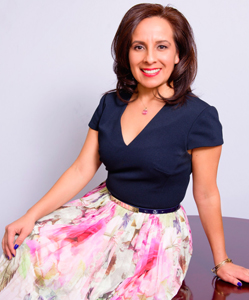This week, TheLatinoAuthor.com is featuring author Graciela Tiscareño-Sato. Ms. Tiscareño-Sato launched her book in 2011. It is titled Latinnovating: Green American Jobs and the Latinos Creating Them. Her background in Environmental Design as well as her passion to provide positive images of Latinos compelled her to write this book. Read our interview with Graciela and see what motivated her to move forward in her writing endeavors and her speaking engagements.


Can you begin by telling us a little bit about yourself; where you grew up, where you currently reside, family upbringing, or anything that you would like our readers to know about you?
I am the daughter of Mexican immigrants in the 1960s, two highly intelligent, loving parents who did not have the opportunity to pursue much education in Mexico. I am the oldest of five children and still the only one of the five children to graduate from college.
Growing up in a meat-packing town in northern Colorado, early in life, I went against the cultural expectations, against the grain in every way. I was academically inclined in math, science and writing; I was a three-sport athlete, the only female trombone player and so on. I had no desire to learn to cook and when my mother said I needed to cook to get a husband, I told her I would marry a man that could cook (and I did!). I published my first article and earned my first byline in my hometown paper when I was 15 years old and did other unusual things like that. They called me rebelde. So I decided to live up to the name.
I won a scholarship from the U.S. Air Force ROTC program, and was admitted to my first choice university: University of California at Berkeley (a.k.a. Cal.) After months of hearing “deveras vas a dejar a tu mama” from the community, my family drove me to Berkeley and dropped me off at the dorms to begin my life as a scholar. Today, I have military officer, aviator and veteran on my resume, along with a master degree in international management, a small business owner, speaker and author. After a decade of active duty service on four continents, we returned to the San Francisco East Bay where I now live with my husband and three young children. Because life loves to keep surprising me, one of my children was a severely premature one pound baby. Today she’s ten years old and healthy but she did lose her sense of sight as a result of her early birth; please add “special needs mom” to my list of descriptions. Never a boring day…
I recently launched a book at Cal’s rival, Stanford University, to showcase Latino leadership stories from the green economy. I am living proof of the value of higher education in changing the trajectory of a young life. I credit my parents for talking about pursuing education (even though they wished I would do it while living at home) and my high school counselor for introducing me to her Air Force officer husband who informed me of the AFROTC scholarship and program. This made it possible for me to sever the ties to home and really focus on developing my mind, away from the domestic responsibilities put on young Latinas with four younger siblings.
How did you get interested in writing non-fiction and why the topic about “Green American Jobs?”
I have published non-fiction articles in trade magazines, and children’s magazines, for years as a freelance writer. I have a natural curiosity about people, their stories and a desire to create content that teaches their life lessons to others. Plus, my own life as a military aviator has provided a lifetime supply of stories, leadership lessons and adventure that I am documenting in my military memoirs. Writing non-fiction content to me has always been more intellectually stimulating than anything else. When I took the Institute for Children’s Literature course, I got through the fiction assignments but it was the non-fiction assignments, the research and writing to present information in a compelling, fun way—that’s what I really loved. It was also those non-fiction articles that I pitched during the course, were published and brought in revenue for my effort.
Another reason I chose this content path: for far too long, I have been bothered by negative media images of Latinos. I find it sad that mainstream American media does not regularly seek and feature successful Latinos like those in my book. I want positive images of Latinos to become part of our collective consciousness as a nation. I’m determined to bring these stories into the light and into the mainstream, to change the conversation about Latinos in America. They won’t come looking for these stories so therefore I will write them and present them so that our entrepreneurial spirit will finally be seen and appreciated by the masses. It’s got to be an intentional effort to show the opposite of the status quo to begin to change minds about the images that the words “Latino” and “Hispanic” represent. It’s what I learned to do as a marketer –if you want to change minds, you must show the success stories.
Why green jobs? Why focus on entrepreneurs innovating to benefit the environment and harm our planet less?
Because of my military aviation career, I have seen from the air and from the ground more of this Earth than most people ever will see. I have tremendous and deep appreciation for our planet because I understand the smallness of it. I get the big picture. That’s a core value. I tell live audiences that it’s only 16 hours to Saudi Arabia – it’s a very small rock we share.
Second, I have worked in a global corporate sustainability role, in an industry creating software-based technologies designed to enable brains to collaborate from wherever they may be, without commuting and polluting. The technologies we developed were also about significant energy reductions for large global corporations – reducing corporate footprints in multiple ways: less energy to operate, less cars on the road and less planes in the air. That experience led me to wonder what, if anything, Latinos were contributing to the American green economy. An article I was commissioned to write for Hispanic MBA magazine gave me the opportunity to explore the curiosity and led me to the people featured in Latinnovating and too many others that will make up future volumes.
I share the culture of the Latino innovators of whom I write. I, like them, have always known not to waste, to always creatively reuse and to always conserve. While Americans generally talk about “going green,” and all the lifestyle changes that represents, we Latinos have already been living this way. It’s who we are. It’s only natural to find Latinos innovating and in positions of leadership in our new green economy. I’m privileged to have been entrusted to tell their stories.
I also have a key message for teachers: I tell educators to stop looking at their Latino students only in socio-economic terms (a.k.a. “disadvantaged”) and instead look at them through a different prism, to see that they’re actually “creatively advantaged” then figure out how to harness that gift. Outcomes typically follow expectations.
What’s a typical working day for you and do you set a daily writing goal?
I write three times a week between 5 and 7 in the morning. At 7 we wake the girls up to get them to school. The rest of my day I market myself as a speaker to universities, associations, etc. I also manage my business, make social media connections, update websites and blogs, and attend marketing seminars and networking events. Additionally, my husband and I have a standing agreement that Thursday nights are my writing nights – I leave the house at dinner time and come back around midnight after hiding out in some café somewhere. It works! Do you feel being a Latino Author has hindered or helped your career as an author?
In my case, it’s been a huge advantage to be a Latina author and professional speaker, focused on presenting these case studies to live audiences at universities and conferences. Only a Latina would put this much work, energy, thought, time and money into a project to spotlight and showcase Latino entrepreneurs! Who else is going to do this? Plus, I have uncovered a big market of organizations looking to bring in Latino speakers and authors. Event organizers (universities and conferences) want to enlighten mixed audiences about the economic contributions of Latinos. The environmental and sustainability communities appreciate a Latino speaker and author to bring fresh perspectives and fresh, innovative examples they’ve never seen. The educational community has responded positively too, understanding that putting stories of successful, highly-educated Latinos in front of Latino students is an essential element to motivate our exploding school-aged population to aspire to follow their footsteps. That the work was created by a Latina with a master degree is very attractive to them as well – they see a role model writing stories about even more role models for their students. Yes, being Latina has indeed been an advantage and continues to be.
What kind of research did you do for your book?
I decided that for readers to appreciate the innovation taking place across the profiled leaders’ industries, they must first understand the status quo in these industries. Therefore, my curiosity ensured that I spent a great deal of time, perhaps too much time, researching the state of each industry I write about in the book. This resulted in a nice, concise primer about each industry, one woven into each chapter. It’s a unique content set in a book that profiles entrepreneurs and innovators. Yes, their personal childhood-to-innovator stories are detailed here, including their educational choices, paths and reasons, but including basic industry information to set the stage for their innovations became a very important learning element that students and readers appreciate.
What were some of the most challenging hurdles you faced in publishing your book?
The most challenging hurdle was also the best opportunity. At the conclusion of the Inaugural Silicon Valley Latino Leadership Summit in 2010, an event I help promote, my dear friend, Frank Carbajal (author of Building the Latino Future) approached me. He said “Get your book done by next year and launch it at our Summit at Stanford.” How could I say no to that offer?
I agreed and that decision put me under the gun in a big way. I put the project plan together and went to work. I was simultaneously interviewing people for the book, writing it, and also interviewing publishers. The short timeline (“I’ll have the manuscript ready by Halloween and need books in hand by late April”) eliminated most publishers. When I did the business case to evaluate the cost and benefit ratios of different publishing options available, I knew I would have to do it in a uniquely entrepreneurial way. I needed to control all intellectual property rights to the Latinnovating brand (which is now officially trademarked), plus all marketing and distribution. I knew already what many authors struggle to accept: I am responsible for the marketing of my books –nobody else. Thank God I have worked professionally as a global product marketer for ten years!
In the end, it was a classic Girl Scout networking moment that led me to my independent publisher: Thrive Publishing. At a birthday party for one of the girls, one of the moms, graphic designer Tammy Tribble said, “You know I work for a publisher in San Francisco, right?” The rest is history. Caterina Rando’s Thrive Publishing team was amazing and I had my books in hand a full three weeks before the launch event at Stanford University! I got the best of both worlds: a professional publishing house and team to produce a gorgeous book and my own company as copyright owner of the work.
Believe it or not, getting each person I profiled to submit a photograph to use in the book was a big hurdle. Perhaps it’s a cultural thing (the need to not feel like we’re overly promoting ourselves,) but it was a surprise to me to experience their resistance to showing their fabulous faces.
What projects or books are you currently working on?
I contribute regularly to The Huffington Post, both the Latino Voices section and the Green section. This gives national (and global) visibility to our entrepreneurial success stories which is very important to me.
Currently I am interviewing the next set of “Latinnovators” for the next book which I hope to launch next year. Ahead of that, on Veterans Day this November, I plan to launch my first children’s book titled “Good Night Captain Mama.” It’s a reassuring, bilingual bedtime book for ages 4-6 to explain the meaning of military service, uniforms and the colorful patches on my flight suit which my son calls my “pilot costume.” I can find no children’s books on the market written by Latina military veterans so I hope to start a trend that will encourage more of us to tell our stories gained through our military service.
Additionally, my deep strategic and product marketing skill set has come in very handy to make me successful as a speaker, getting a national distributor (Baker and Taylor) as an indi author, and in selling books at conferences. I’m available to help other Latino authors write their marketing plans, launch bestseller campaigns, create and execute social media strategy and market themselves as professional speakers.
Visit me at http://www.latinnovating.com!




